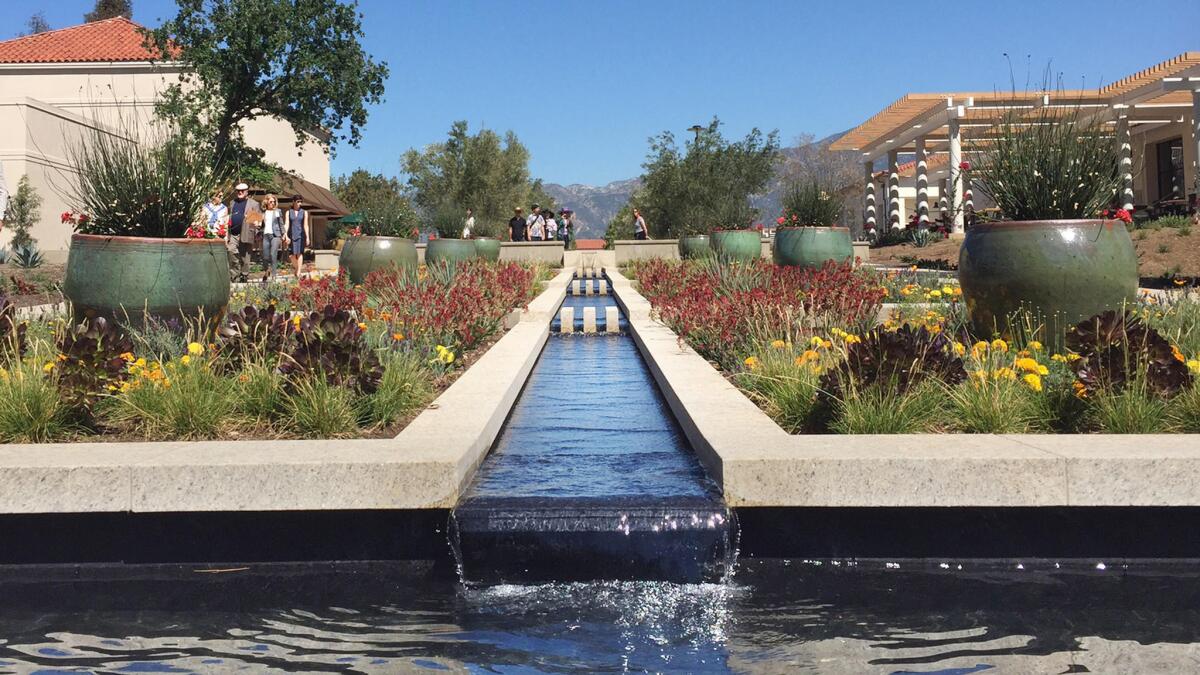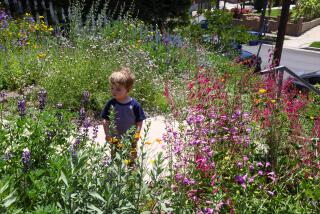L.A. museums and the art of water conservation

The Huntington Library, Art Collections and Botanical Gardens has cut the amount of lawn on its property in half and planted its new Koblik Education and Visitor Center, above, with California natives and dry-climate plants in order to combat the California drought.
The reach of the California drought has extended to some high-profile art museums with lush gardens and abundant water features. Here’s what three key Los Angeles-area institutions are doing to cut back:
Huntington Library, Art Collections, and Botanical Gardens, San Marino
The Huntington, with its 207 acres planted with exotic flora, faces big challenges when it comes to water conservation.
The museum said it has cut the amount of lawn on the property in half — from about 18 acres to nine. The remaining lawn receives less water than it used to, as does the property’s rose garden, which has cut its water usage by 40%. The garden’s curator, Tom Carruth, is using the site to teach visitors that roses can be drought-tolerant.
Various gardens are being retrofitted with irrigation systems designed to reduce waste with low-flow sprinkler heads. The new Steven S. Koblik Education and Visitor Center is planted with California native plants, a first for the Huntington.
The museum has developed an online resource, huntington.org/water, to outline the steps it’s taking.
The Getty Center (and the Getty Villa)
In June 2014, both locations turned off all water fountains and drained all pools except for the fish-inhabited ones and one designed by Robert Irwin, an art installation at the Getty Center that is considered part of the museum’s collection.
More recently, the Getty has begun installing more drought-tolerant plants, a leak-detection system and drip irrigation. It has also found a more efficient way of delivering needed humidity to exhibition rooms.
Turning off the fountains alone saves nearly 2,500 gallons a day. The Getty said it has reduced the amount of water it uses by 55% since the Getty Center opened in 1997.
Los Angeles County Museum of Art
LACMA representatives said that as the pressures of the drought have grown, the museum has adopted water-saving measures, including working with the nonprofit Arts Earth Partnership, with a specific focus on water efficiency.
Staff members regularly check for leaks in all areas of the campus, waterless urinals are used throughout all buildings and low-flow sensor faucets have been installed throughout. Water use in cleaning also is being reduced.
Irrigation systems are being replaced with smart weather-base controllers, and the watering schedule is being closely monitored with the goal of reducing irrigation run times.
The museum reuses water from exhibitions in the landscape, and planting areas are being mulched to increase moisture retention.
A number of water conservation projects are in the works, including shutting off the Dorothy Collins Brown fountain that runs along the staircase from Wilshire Boulevard up to the Bing Theater, and significantly reducing planting at the Spaulding Avenue parking lot by about 80% and replacing it with decomposed granite.
More to Read
The biggest entertainment stories
Get our big stories about Hollywood, film, television, music, arts, culture and more right in your inbox as soon as they publish.
You may occasionally receive promotional content from the Los Angeles Times.











